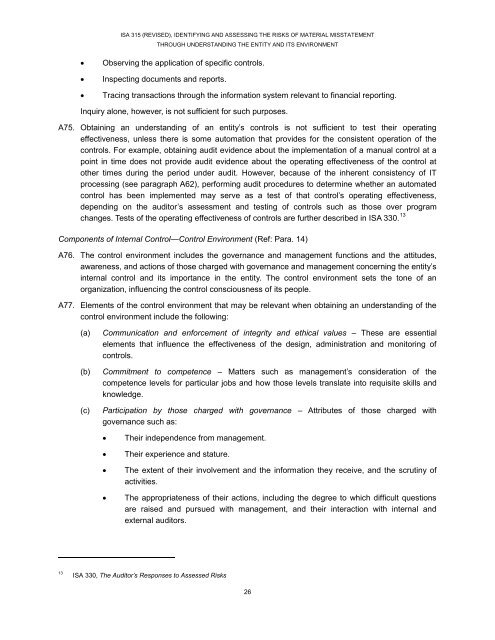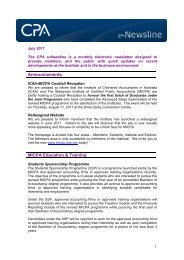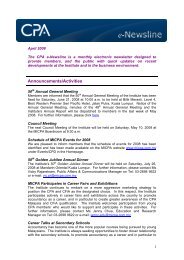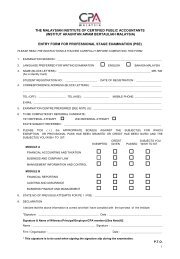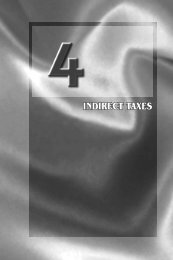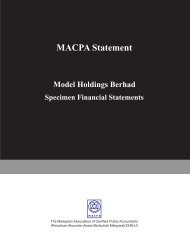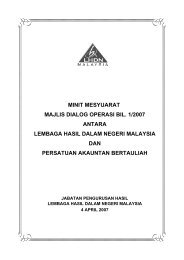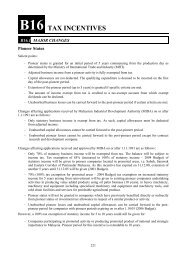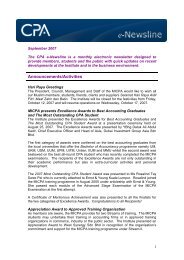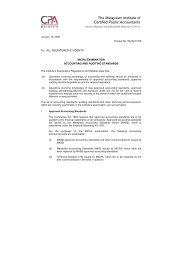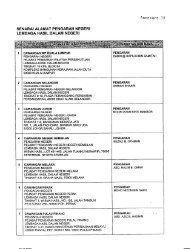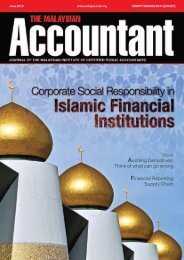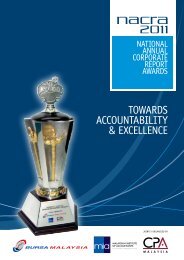ISA 315 (REVISED), IDENTIFYING AND ASSESSING THE RISKS OF MATERIAL MISSTATEMENTTHROUGH UNDERSTANDING THE ENTITY AND ITS ENVIRONMENTThe nature <strong>of</strong> <strong>the</strong> entity’s business, including its organization <strong>and</strong> ownership characteristics.The diversity <strong>and</strong> complexity <strong>of</strong> <strong>the</strong> entity’s operations.Applicable legal <strong>and</strong> regulatory requirements.The circumstances <strong>and</strong> <strong>the</strong> applicable component <strong>of</strong> internal control.The nature <strong>and</strong> complexity <strong>of</strong> <strong>the</strong> systems that are part <strong>of</strong> <strong>the</strong> entity’s internal control,including <strong>the</strong> use <strong>of</strong> service organizations.Whe<strong>the</strong>r, <strong>and</strong> how, a specific control, individually or in combination with o<strong>the</strong>rs, prevents, ordetects <strong>and</strong> corrects, material misstatement.A69. Controls over <strong>the</strong> completeness <strong>and</strong> accuracy <strong>of</strong> information produced by <strong>the</strong> entity may berelevant to <strong>the</strong> audit if <strong>the</strong> auditor intends to make use <strong>of</strong> <strong>the</strong> information in designing <strong>and</strong>performing fur<strong>the</strong>r procedures. Controls relating to operations <strong>and</strong> compliance objectives may alsobe relevant to an audit if <strong>the</strong>y relate to data <strong>the</strong> auditor evaluates or uses in applying auditprocedures.A70. Internal control over safeguarding <strong>of</strong> assets against unauthorized acquisition, use, or dispositionmay include controls relating to both financial reporting <strong>and</strong> operations objectives. The auditor’sconsideration <strong>of</strong> such controls is generally limited to those relevant to <strong>the</strong> reliability <strong>of</strong> financialreporting.A71. An entity generally has controls relating to objectives that are not relevant to an audit <strong>and</strong> <strong>the</strong>reforeneed not be considered. For example, an entity may rely on a sophisticated system <strong>of</strong> automatedcontrols to provide efficient <strong>and</strong> effective operations (such as an airline’s system <strong>of</strong> automatedcontrols to maintain flight schedules), but <strong>the</strong>se controls ordinarily would not be relevant to <strong>the</strong>audit. Fur<strong>the</strong>r, although internal control applies to <strong>the</strong> entire entity or to any <strong>of</strong> its operating units orbusiness processes, an underst<strong>and</strong>ing <strong>of</strong> internal control relating to each <strong>of</strong> <strong>the</strong> entity’s operatingunits <strong>and</strong> business processes may not be relevant to <strong>the</strong> audit.Considerations Specific to Public Sector EntitiesA72. Public sector auditors <strong>of</strong>ten have additional responsibilities with respect to internal control, forexample, to report on compliance with an established code <strong>of</strong> practice. Public sector auditors canalso have responsibilities to report on compliance with law, regulation or o<strong>the</strong>r authority. As a result,<strong>the</strong>ir review <strong>of</strong> internal control may be broader <strong>and</strong> more detailed.Nature <strong>and</strong> Extent <strong>of</strong> <strong>the</strong> Underst<strong>and</strong>ing <strong>of</strong> Relevant Controls (Ref: Para. 13)A73. Evaluating <strong>the</strong> design <strong>of</strong> a control involves considering whe<strong>the</strong>r <strong>the</strong> control, individually or incombination with o<strong>the</strong>r controls, is capable <strong>of</strong> effectively preventing, or detecting <strong>and</strong> correcting,material misstatements. Implementation <strong>of</strong> a control means that <strong>the</strong> control exists <strong>and</strong> that <strong>the</strong>entity is using it. There is little point in assessing <strong>the</strong> implementation <strong>of</strong> a control that is noteffective, <strong>and</strong> so <strong>the</strong> design <strong>of</strong> a control is considered first. An improperly designed control mayrepresent a significant deficiency in internal control.A74. Risk assessment procedures to obtain audit evidence about <strong>the</strong> design <strong>and</strong> implementation <strong>of</strong>relevant controls may include:Inquiring <strong>of</strong> entity personnel.25
ISA 315 (REVISED), IDENTIFYING AND ASSESSING THE RISKS OF MATERIAL MISSTATEMENTTHROUGH UNDERSTANDING THE ENTITY AND ITS ENVIRONMENTObserving <strong>the</strong> application <strong>of</strong> specific controls.Inspecting documents <strong>and</strong> reports.Tracing transactions through <strong>the</strong> information system relevant to financial reporting.Inquiry alone, however, is not sufficient for such purposes.A75. Obtaining an underst<strong>and</strong>ing <strong>of</strong> an entity’s controls is not sufficient to test <strong>the</strong>ir operatingeffectiveness, unless <strong>the</strong>re is some automation that provides for <strong>the</strong> consistent operation <strong>of</strong> <strong>the</strong>controls. For example, obtaining audit evidence about <strong>the</strong> implementation <strong>of</strong> a manual control at apoint in time does not provide audit evidence about <strong>the</strong> operating effectiveness <strong>of</strong> <strong>the</strong> control ato<strong>the</strong>r times during <strong>the</strong> period under audit. However, because <strong>of</strong> <strong>the</strong> inherent consistency <strong>of</strong> ITprocessing (see paragraph A62), performing audit procedures to determine whe<strong>the</strong>r an automatedcontrol has been implemented may serve as a test <strong>of</strong> that control’s operating effectiveness,depending on <strong>the</strong> auditor’s assessment <strong>and</strong> testing <strong>of</strong> controls such as those over programchanges. Tests <strong>of</strong> <strong>the</strong> operating effectiveness <strong>of</strong> controls are fur<strong>the</strong>r described in ISA 330. 13Components <strong>of</strong> Internal Control—Control Environment (Ref: Para. 14)A76. The control environment includes <strong>the</strong> governance <strong>and</strong> management functions <strong>and</strong> <strong>the</strong> attitudes,awareness, <strong>and</strong> actions <strong>of</strong> those charged with governance <strong>and</strong> management concerning <strong>the</strong> entity’sinternal control <strong>and</strong> its importance in <strong>the</strong> entity. The control environment sets <strong>the</strong> tone <strong>of</strong> anorganization, influencing <strong>the</strong> control consciousness <strong>of</strong> its people.A77. Elements <strong>of</strong> <strong>the</strong> control environment that may be relevant when obtaining an underst<strong>and</strong>ing <strong>of</strong> <strong>the</strong>control environment include <strong>the</strong> following:(a)(b)(c)Communication <strong>and</strong> enforcement <strong>of</strong> integrity <strong>and</strong> ethical values – These are essentialelements that influence <strong>the</strong> effectiveness <strong>of</strong> <strong>the</strong> design, administration <strong>and</strong> monitoring <strong>of</strong>controls.Commitment to competence – Matters such as management’s consideration <strong>of</strong> <strong>the</strong>competence levels for particular jobs <strong>and</strong> how those levels translate into requisite skills <strong>and</strong>knowledge.Participation by those charged with governance – Attributes <strong>of</strong> those charged withgovernance such as:Their independence from management.Their experience <strong>and</strong> stature.The extent <strong>of</strong> <strong>the</strong>ir involvement <strong>and</strong> <strong>the</strong> information <strong>the</strong>y receive, <strong>and</strong> <strong>the</strong> scrutiny <strong>of</strong>activities.The appropriateness <strong>of</strong> <strong>the</strong>ir actions, including <strong>the</strong> degree to which difficult questionsare raised <strong>and</strong> pursued with management, <strong>and</strong> <strong>the</strong>ir interaction with internal <strong>and</strong>external auditors.13ISA 330, The Auditor’s Responses to Assessed <strong>Risks</strong>26
- Page 1 and 2: ISA 315(Revised)Issued August 2012I
- Page 3 and 4: ISA 315(Revised)The application and
- Page 5 and 6: ISA 315 (REVISED), IDENTIFYING AND
- Page 8 and 9: ISA 315 (REVISED), IDENTIFYING AND
- Page 10 and 11: ISA 315 (REVISED), IDENTIFYING AND
- Page 12 and 13: ISA 315 (REVISED), IDENTIFYING AND
- Page 14 and 15: ISA 315 (REVISED), IDENTIFYING AND
- Page 16 and 17: ISA 315 (REVISED), IDENTIFYING AND
- Page 18 and 19: ISA 315 (REVISED), IDENTIFYING AND
- Page 20 and 21: ISA 315 (REVISED), IDENTIFYING AND
- Page 22 and 23: ISA 315 (REVISED), IDENTIFYING AND
- Page 24 and 25: ISA 315 (REVISED), IDENTIFYING AND
- Page 28 and 29: ISA 315 (REVISED), IDENTIFYING AND
- Page 30 and 31: ISA 315 (REVISED), IDENTIFYING AND
- Page 32 and 33: ISA 315 (REVISED), IDENTIFYING AND
- Page 34 and 35: ISA 315 (REVISED), IDENTIFYING AND
- Page 36 and 37: The Use of AssertionsISA 315 (REVIS
- Page 38 and 39: ISA 315 (REVISED), IDENTIFYING AND
- Page 40: ISA 315 (REVISED), IDENTIFYING AND
- Page 43 and 44: ISA 315 (REVISED), IDENTIFYING AND
- Page 45 and 46: ISA 315 (REVISED), IDENTIFYING AND
- Page 47: ISA 315 (REVISED), IDENTIFYING AND


